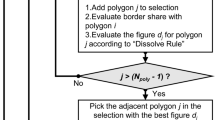Abstract
This study describes the full disaggregation process of emission inventory maps in support of environmental modeling studies in a geographical information system. Using a heuristic approach, appropriate algorithms were found to accelerate the computational disaggregation speed. The algorithms were based on scan-conversion algorithms employed in the field of computer graphics. Various algorithms were analyzed in terms of supporting emission inventories with different shapes, such as points, polylines and polygons. The algorithms were implemented by using Visual Basic, thereby enabling the efficiencies of the algorithms to be analyzed and compared with each other. For the disaggregation of polygon types, with the aim of increasing the resolution of an inventory map, we suggest the advanced polygon-disaggregation method with land use data. An air dispersion simulation was performed in order to compare the accuracy of the emission input data generated by existing disaggregation methods and the advanced method proposed in the present study.
Similar content being viewed by others
References
R. Berkowicz, M. Winther and M. Ketzel, Environ. Modell. Softw., 21, 454 (2006).
A. Jeaecker-Voirol and P. Pelt, Environ. Modell. Softw., 15, 575 (2000).
F. Monforti and A. Pederzoli, Environ. Modell. Softw., 20, 505 (2005).
J. M. Armstrong and A. M. Khan, Comput. Environ. Urban, 28, 421 (2004).
J. Hao, H. Tian and Y. Lu, Environ. Sci. Technol., 36, 552 (2002).
P. Symonidis, I. Ziomas and A. Proyou, Environ. Modell. Softw., 19, 413 (2004).
D.Q. Tong, N. Z. Muller, D. L. Mauzerall and R.O. Mendelsohn, Environ. Sci. Technol., 40, 1395 (2006).
W. Winiwarter and G. Schimak, Environ. Modell. Softw., 20, 1469 (2005).
Lakes Environmental Software, Inc., User’s guide for the Industrial Source Complex (ISC3) dispersion models, http://support.lakesenvironmental.com/Models/ISC3Docs/isc3v1.pdf (2006).
T.W. Tesche, R.M. Morris, G. Tonnesen, D. McNally, J. Boylan and P. Brewer, Atmos. Environ., 40, 4906 (2006).
D. Tuia, M. Osses de Eicker, R. Zah, M. Osses, E. Zarate and A. Clappier, Atmos. Environ., 41, 3658 (2007).
M. Osses de Eicker, R. Zah, R. Trivino and H. Hurni, Atmos. Environ., 42, 1491 (2008).
D. A. Niemeier and Y. Zheng, Environ. Sci. Technol., 38, 2133 (2004).
J. Dai and D. M. Rocke, Environ. Modell. Softw., 15, 293 (2000).
M. Dalvi, G. Bieg, U. Patil, A. Kaginalkar, C. Sharma and A. P. Mitra, Atmos. Environ., 40, 2995 (2006).
V. Aken JR., IEEE Comput. Graph., 4, 24 (1984).
J. E. Bresenham, IBM Syst. J., 4, 25 (1965).
P. L. Gardner, IBM Technol. Disclosure B., 18, 1595 (1975).
G. Gill, IEEE Comput. Graph., 14, 66 (1994).
A. Haque, M. S. Rahman, M. Bakht and M. Kaykobad, Comput. Graph., 30, 207 (2006).
C.-W. Huang and T.-Y. Shih, Comput. Geosci., 23, 109 (1997).
M. R. Kappel, An ellipse-drawing algorithm for raster displays. In: Fundamental algorithms for computer graphics, Springer: Berlin (1985).
U. Manber, Introduction to algorithms; a creative approach, Addison-Wesley Publishing Co., Reading, Massachusetts (1989).
M. L. V. Pitteway, Comput. J., 10, 282 (1967).
F. P. Preparata and M. I. Shamos, Computational geometry: An introduction, 2nd ed. Springer, New York (1985).
B. Zalik and G. J. Clapworthy, Comput. and Graph., 23, 353 (1999).
B. Zalik and I. Kolingerova, Comput. Geosci., 27, 1135 (2001).
TRC Companies, Inc., A user’s guide for the CALPUFF dispersion model, http://www.src.com/verio/download/CALPUFF_UsersGuide.pdf (2006).
Environmental Systems Research Institute, Inc., ESRI Shapefile Technical Description, printed in the United States of America, http://www.esri.com/library/whitepapers/pdfs/shapefile.pdf (1998).
X. Wu and J. G. Rokne, Comput. Graph. Image Anal., 37, 331 (1987).
P. Stephenson and B. Litow, Comput. Graph., 25, 681 (2001).
F. Xia, Pattern Recogn., 36, 1383 (2003).
H. Park, S. Chah, E. Choi, H. Kim and J. Yi, Atmos. Environ., 36, 4851 (2002).
M.-S. Kim, J. H. Kim, H.-S. Park, Y. S. Sun, H.-S. Kim, K. H. Choi and J. Yi, Korean J. Chem. Eng., 23, 919 (2006).
M.-S. Kim, J. H. Kim, H.-S. Park, Y. S. Sun, H.-S. Kim, K. H. Choi and J. Yi, Korean J. Chem. Eng., 24, 763 (2007).
Author information
Authors and Affiliations
Corresponding author
Rights and permissions
About this article
Cite this article
Kim, J.H., Kwak, B.K., Shin, C.B. et al. Speed-up of the disaggregation of emission inventories and increased resolution of disaggregated maps using landuse data. Korean J. Chem. Eng. 26, 1620–1629 (2009). https://doi.org/10.1007/s11814-009-0280-x
Received:
Accepted:
Published:
Issue Date:
DOI: https://doi.org/10.1007/s11814-009-0280-x




